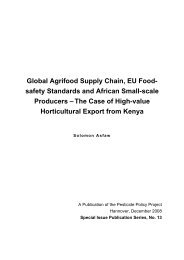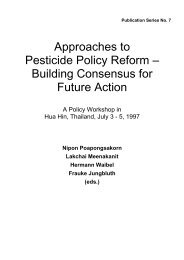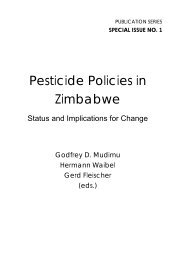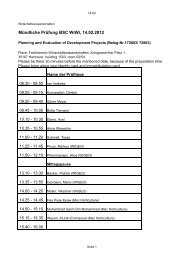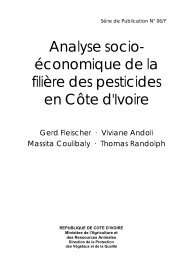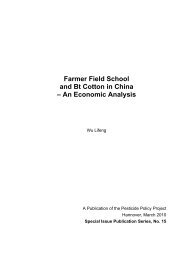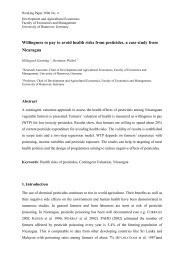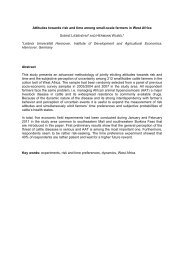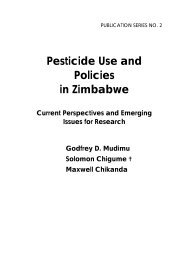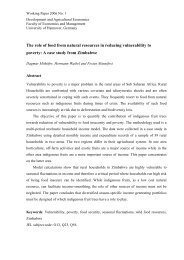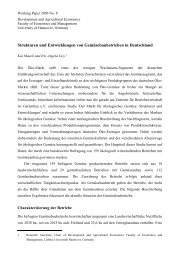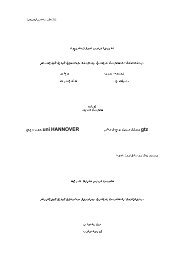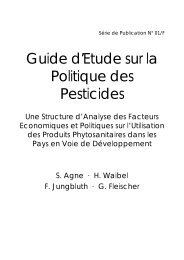PPP Special 08 - Institut für Entwicklungs- und Agrarökonomik
PPP Special 08 - Institut für Entwicklungs- und Agrarökonomik
PPP Special 08 - Institut für Entwicklungs- und Agrarökonomik
You also want an ePaper? Increase the reach of your titles
YUMPU automatically turns print PDFs into web optimized ePapers that Google loves.
xii<br />
Summary<br />
This study on the economics of Bt cotton in the state of Karnataka was<br />
conducted during the first year of commercial introduction of Bt cotton in India.<br />
It is based on a survey of 100 farmers in the 2002/2003 cropping season that<br />
included farmers that had purchased Bt cotton and others who planted<br />
conventional, non-transgenic varieties. Simple statistical and economic<br />
analyses have been carried out in order to derive baseline information for an<br />
early impact assessment of Bt crops in developing countries. Comparisons<br />
were made across farms for farmers who planted Bt and those who planted<br />
non-Bt cotton varieties. In addition, pair wise on-farm comparisons were made<br />
of farmers who had planted both types of cotton.<br />
Although the sample size was small and in this very early phase the access to<br />
Bt seed was still limited, a number of important observations can be made.<br />
Firstly, there seemed to have been a lack of knowledge regarding the true<br />
biological characteristics of Bt cotton among farmers and extension agents.<br />
Many farmers simply assumed that Bt cotton was a high yielding variety that<br />
would not need any pesticides. Secondly, farmers listed the high costs of seed<br />
as a major disadvantage. Seed company agents, which were fo<strong>und</strong> to be the<br />
major source of information justified high Bt seed costs with high yield<br />
promises. Thirdly, the economic analysis showed that the economic advantage<br />
of Bt cotton depends on the agronomic conditions. While the gross margin for<br />
Bt was higher although not statistically significant if farmers had good access<br />
to irrigation the opposite was true for cotton production <strong>und</strong>er rain fed<br />
conditions. Fourthly, pesticide costs were not the major cost item and the<br />
difference in seed cost between Bt and non-Bt was higher than the difference<br />
in pesticide cost. Hence, during years with low bollworm attack planting of<br />
Bt varieties can be a costly prophylactic pest control treatment that can reduce<br />
farmer’s ability to cope with different pests later in the season.<br />
The conclusion of the study is that Bt is an additional option of cotton pest<br />
management also for developing countries. The benefits of the technology<br />
depend on the institutional and ecological conditions of the adopters. While<br />
some prospects seem to exist for irrigated areas, <strong>und</strong>er rain fed conditions,<br />
which is about two thirds of the cotton area in India, Bt can be an expensive<br />
and inflexible pest management tool. Given the constraints that were fo<strong>und</strong> in<br />
the state of Karnataka one should perhaps not be too optimistic on the<br />
potential of Bt crops to sustainably solve pest management problems in cotton<br />
especially in developing countries. Yield differences do not always<br />
translate into differences in profit and the actual reduction in pesticide



